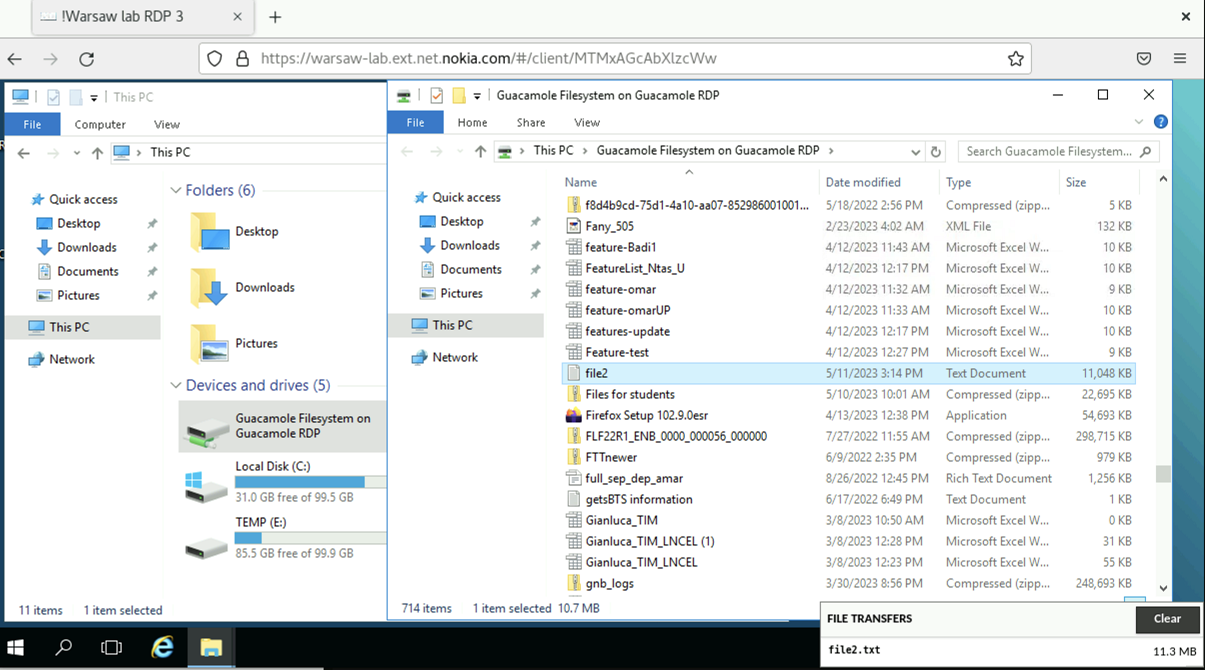
Lab Access Cloud Quick Start Guide
Last updated on 07 February 2017
Contents
1
General information
2 Requirements
3 Copy & Paste,
Filetransfer, Fullscreen mode
4 Sharing,
share interactively
5 Troubleshooting
1
General information
1.1 Purpose
This document offers a basic guide how to use Lab Access Cloud connections. It covers access to Labs reserved for NokiaEDU Training.
1.2 Intended recipients
Every user who is authorized to access the Lab Access Cloud solution.
1.3 What is needed
You need a supported web browser and access to the Internet or the Nokia Intranet. The supported browsers are Google Chrome, Chromium, Internet Explorer (>= version 10), Mozilla Firefox, Safari, Midori or Opera Browser. For direct Copy & Paste, we recommend Google Chrome, the Open Source variant Chromium or Internet Explorer. To enable clipboard transfers for Chrome based browsers, you must install an extension (see chapter 3). The Internet Explorer supports by default, if you allow it.
Important: In Internet Explorer the "Compatibility mode" must be disabled. Otherwise you will get no login screen.
1.4 How to connect
In your web browser open the link the Testbed provided to
you. This can be the local LAC Access Point or a link to the global portal.
Anyway if you expect speed issues,
open the global portal:
TSP
Nokia Connection Test Tool and choose the NokiaEDU Training Lab, that is reserved for
you.
You will get a result with available Nokia LAC Access Points, assigned to the selected NokiaEDU Training Lab with the fastest Access Point at the top.

Choose the fastest Access Point and then enter the credentials you have got from NokiaEDU Training Lab Administration:

After login depending on the type of reservation, you get a start page with available connections or you are connected directly using Single Sign On to a Terminalserver.


You can download also a short MP4 video,
that illustrates the practical use:
How to use Lab
Access Cloud

1.5 Do I have direct lab access after login?
No, you have a virtual lab connection inside the browser only. You do not have direct lab connectivity from your local operating system. No VPN is established or necessary.
1.6 How to get support
In case of Lab access problems, please check again the requirements and if still in trouble, please consult the Troubleshooting & FAQ page or contact the NokiaEDU Team.
2 Requirements
2.1 What web browser is supported
We support Google Chrome, Chromium, Internet Explorer (at least v10, with compatibility mode disabled), Mozilla Firefox, Safari, Midori and Opera. We recommend Google Chrome. Internet Explorer or Edge work usually without problems, if you deactivate "Compatibility Mode".
2.2 Is Java or Citrix Receiver needed?
No, you only need a supported web browser. No additional installation is neccessary.
2.3 What version of web browser is needed
At least all actual Chrome based browsers, Internet Explorer 10, Firefox (at least v32) and any relatively actual HTML5 capable browser should work. Please report us any issues with supported browsers.
2.4 What connection speed is needed
Based on the measurements, these are needed per user:
· minimum download bandwidth 200kbps/user
· minimum upload bandwidth 100kbps/user
· latency < 500 millisecond
Even with worse values the connection will work, but the handling may be delayed and continuous disconnects can occur. Most NokiaEDU Training Labs have assigned additional Access Points in different countries, that may offer a better connection quality. You can easily check by running the Nokia Connection Test Tool.
2.5 How to check connection speed
There are two ways to check connection speed. Please prefer
the
Nokia Connection Test Tool
on TSP , because even if the Access Point of your choice is
not reachable from your location, you can run a test to all available NokiaEDU
Access Points:
The other way is to open the NokiaEDU Training Lab Access Point and click on "Click to run Speedtest".
·

2.6 Problem report and assistance
If you have problems accessing the Lab Access Cloud, please contact local NokiaEDU Training Lab Administration or global NokiaEDU team.
3 Copy & Paste, Filetransfer Fullscreen mode
3.1 Guacamole plugin for Google Chrome
It is possible to directly copy text to/from (c&p) your Lab session using the extension for Google Chrome and Chromium. Internet Explorer since version 11 even supports by default without additional extension. The extension for Chrom based browsers is currently not available for other browsers, but planned also for Firefox. You will find the Chrome extension here: https://chrome.google.com/webstore/detail/clipboard-permission-mana/ipbhneeanpgkaleihlknhjiaamobkceh
To enable, you must add the extension from link above, open the login page and enable clipboard access for this page like shown below:

3.2 How to copy a text
If you don’t use the Chrome plugin, you can copy text after you press Ctrl+Alt+Shift at the same time in your LAC session (within connection window - not Login Screen). This will open the LAC menu, which will help to copy the text using standard Copy & Paste method. To hide the sidebar, press the Ctrl+Alt+Shift again.

File transfers between local computer and the Lab are easy to do with the network drive G:, which is automatically created in RDP session, if the Testbed administrator enabled and allowed it. To copy from local computer to the lab - use drag and drop to the browser window. The files will be visible in the main directory of the G drive:


To copy files from Lab server to the local computer, please copy them to G:\Download folder. This special folder will handle it as a web browser download







